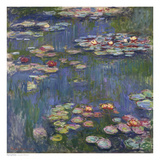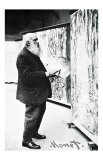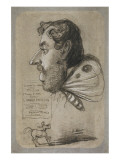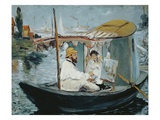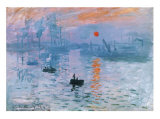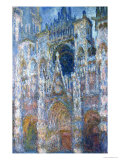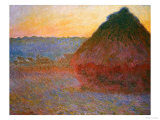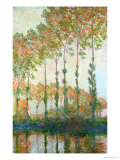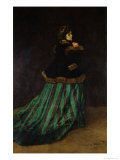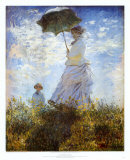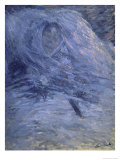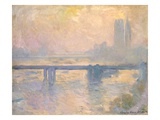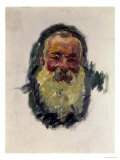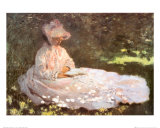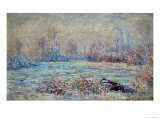Claude Monet, Impressionist Artist: Educational Posters, Prints, Books, Video, Links for Learning |
||||||||||||||||||||||||||||||||||
|
history of art > Impressionists > CLAUDE MONET < famous men < social studies |
||||||||||||||||||||||||||||||||||
|
Claude Monet Claude Monet, a leader in the "Impressionism" school of painting in late 19th Century, was born in Paris but spent his youth in Le Havre, where he began his long art career as a caricaturist and managed to save his fees so he had the freedom to study art over the wishes of his father. In 1858 and 1859 he experiemented with painting outdoors, plein-air, under the guidance of Boudin, (and later Jongkind,) both of whom were interested in the effects of light upon objects and in capturing ‘the moment’, and met a young Camille Pissarro at the Atelier Suisse in Paris. Beginning in 1861 Monet fulfilled two years of a seven year French military commitment in Algeria before falling ill with typhoid. After recovering, and his father buying his way out of the army, Monet returned to Paris to study at the Académie Gleyre, where he met Renoir, Sisley, and Bazille. The associations and conversations between these four young men, as well as Pissarro, Cezanne and Manet, helped Monet develop the luminous style that is most closely associated with the Impressionist movement.
During a stay in England (1870-71) while Monet avoided the Franco-Prussian War (his friend Bazille was killed in action) he studied the works of Constable and Turner. After returning to France he set up his own studio on a boat at Argenteuil to paint how nature is reflected in water. Between 1872 and 1878, Monet's friends gathered about him in a movement that would come to be called “Impressionism”, and flourished in an atmosphere of friendship and mutual ideas.
In 1878 Monet moved to Vetheuil, and then to Giverny in 1883, where he was eventually able to purchase the property and construct his famous gardens. Monet's studies of light and atmosphere are documented in the series of Haystacks, Poplars, and Rouen Cathedral, in a process where he set up in the same place daily, switching canvases as the appearance of the object changed with time of day.
Monet's work can be seen in a continuum from Constable, Corot and Turner to some of the early abstract artists and is regarded as one of the greatest artists and innovators of the Modern Era. To understand the artistic journey he traveled one only needs to compare the first painting he received recognition for in the 1866 Salon de Paris, “Camille, or the Woman in the Green Dress” to his last giant canvases of water lilies almost hallucinatory effect which may somewhat be a attributed of his failing eye sight. I think it is interesting that the artists were cultural precursors into the study and effects of light; Albert Einstein, at the age of 16 in 1894, began doing his famous thought experiments about the speed of light. Monet Quotes ~ |
||||||||||||||||||||||||||||||||||
• CLAUDE MONET BOOKS, VIDEOMonet’s Years at Giverny: Beyond Impressionism by Daniel Wildenstein - Without question Claude Monet is best known for his garden-scapes of ponds, lillies, and blankets of radiant flowers. This period of the artist’s life reflects the 40 years that he spent at his country home in Giverny, a beautiful retreat nestled on the Seine in northern France. Collected within this edition are 81 paintings from these years, accompanied with a fascinating narrative on Monet’s life, loves, and influences. Recounting Monet’s development from an Impressionist to an innovative abstractionist, the book is both informative to read, and exquisite to look at. A Picnic with Monet by Julie Merberg - imaginative board book featuring beautiful paintings by Claude Monet paired with playful, rhyming text is a fun introduction to art. Color Your Own Monet Paintings Thirty ready-to-color drawings, with identifying captions, depict Monet's famous Water Lilies I, The Regatta at Argenteuil, The Boardwalk at Trouville, and others. Actual paintings are shown in full-color on the covers. Paint Like Monet (Masterclass) Monet’s revolutionary approach to painting allowed a new understanding of light, composition, and form. By exploring how his paintings were conceived, constructed, and executed, aspiring artists can broaden their technical knowledge and vastly expand their creative horizons. The first in a new series of instructional books, Paint Like Monet takes the reader on a guided journey through the artist’s methods, tools, materials, and techniques. Step-by-step exercises and detailed explanations of composition and context are complemented by ideas on developing a personal style and tips on how to check and improve a painting in progress. This hands-on encounter with Impressionist theory is rich with insight and inspiration for anyone interested in art—offering a master class with one of history’s greatest artists. Monet (Masters of Art Series) Comprehensive text, written by distinguished art historians, provide incisive and informative portrait of Monet and perceptive commentaries on his works and achievements, features 40 full-page, full-color plates accompanied by commentary on the facing page. Monet and the Impressionists for Kids: Their Lives and Ideas, 21 Activities – invites children to delight in Cassatt's mothers and children, Renoir's dancing couples, and Gaugin's island scenes; 21 activities explore Monet's quick shimmering brush strokes, Cezanne's brilliant rectangles of color, Seurat's pointillism, and Degas's sculpture-like circles of dancers. Kids will learn how the artists' friendships sustained them through repeated rejection by the Parisian art world, and how they lived, painted, and thrilled to the vibrant life of Paris at the approach of the 20th century. Monet Art Activity Pack (Art Activity Packs) by Mila Boutan - In this innovative new series, readers will learn about four of the world’s best known artists -Monet, Matisse, Cezanne, and Van Gogh - and they’ll also get activity ideas that will inspire them to create their own masterpieces. Each Art Activity Pack comes with a paperback book about the artist and focuses on one of the concepts behind his work. In addition, the Cezanne, Monet and Van Gogh Packs include an art activity book and a poster to color. The Matisse Pack includes stencils and brightly colored paper young artists can cut to create their own collages. Linnea in Monet’s Garden (1992) ~ DVD - Lena Anderson and Christina Bjork have turned their popular children’s book into a charming, simply animated introduction to the work of Impressionist painter Claude Monet. Linnea, a vibrant little Swedish girl, is intrigued by the paintings of gardens she sees in a book in the home of her friend, Mr. Bloom. Together they go to Paris, where they visit the Marmottan, a little-known museum with an exceptional collection of Monets. Linnea discovers the familiar paintings are just "blobs and smears" up close, but become recognizable flowers when seen at the proper distance. Mr. Bloom explains that Monet sought to suggest the play of light on water and foliage, rather than recording it in detail. The next day, they make their pilgrimage to Giverny, to walk amid the scenery Monet painted. Linnea is bright and well-mannered but never priggish; her relationship with Mr. Bloom suggests mutual affection and respect. The animation itself is fairly minimal-comparable to Saturday morning cartoons-but the story and well-photographed paintings make up for its limits. The Impressionists: Monet VHS -
|
||||||||||||||||||||||||||||||||||
|
previous page | top |
|
|
|
NPW home | Global PathMarker Collection | APWTW Blog | faqs-about | contact | search | privacy |
|
NetPosterWorks.com ©2007-2015 The Creative Process, LLC All Rights Reserved. |
last updated



